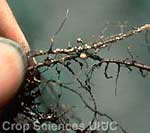Soybean Cyst Nematode (SCN)

Symptoms:
- SCN infects roots and aboveground symptoms are not always present even though yield loss due to SCN may significant.
- The disease is best diagnosed by looking for tiny white to yellow lemon-shaped females on the roots beginning toward the end of June and then throughout the rest of the season.
- The cysts often become brown late in the season.
- In fields with very high levels of SCN, heavily infected plants may be stunted and yellow or chlorotic, particularly under low fertility or drought conditions.
- Badly infested areas may be oval to somewhat elliptical in outline.
- Such areas show the most severe damage in the center with less damage toward the margin.
Pathogen Involved:
- Heterodera glycines (a nematode).
- Host range includes soybean and numerous legume and weed species.
- Numerous different types of the nematode occur that are pathogenic to different sources of resistance.
Conditions Favoring Disease:
- Planting continuous susceptible soybeans.
- Susceptible soybeans grown every other year in rotation.
- Moisture and fertility stress can enhance disease.
Disease Management:
- The first step is to test soil samples to determine if SCN is in a field.
- Soybeans should be rotated with non-host crops.
- Resistant soybean varieties should be planted, and different resistant varieties should be rotated.
- Manage weeds, moisture, and fertility to reduce plant stress.